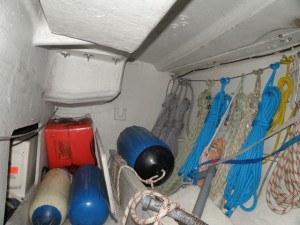Battery conundrums

In April, I will be heading to the boat two weeks ahead of Justin, as he’ll join me for the final week of the trip to move the boat to RI. We have decided that instead of paying a professional to install our expensive instruments, do some critical maintenance and install some of the other replacement parts on Shearwater, that we are going to take the opportunity to learn the boat inside and out. What better way to do this, but to “train the weakness” (in triathlon, our focus was always to evaluate where we were in the swim, bike and run – and we would train in blocks to focus on the weaker legs, in order to race well)? For electronics and mechanical items on previous boats, Justin handled a lot of the tasks (although I helped quite a bit, so I’m not clueless), so we decided that I should be the lead for these tasks. By giving me the opportunity to 1) research, 2) plan, and 3) execute these installations, we’ll both benefit tremendously. We’re both spending a lot of time discussing and planning, but I’ll be on the boat for two weeks working on projects by myself, with input from Justin from afar. We’re both pretty excited and happy with this approach.
We have a rather extensive sailing library that we’ve kept intact, despite several minimalism-inspired “thing” purges. I’ve been reading Nigel Calder’s, “Boatowner’s Mechanical and Electrical Manual” and put together a summary of our anticipated electrical draws from the equipment we have/expect to have onboard (note that several items in strikethrough are not currently onboard and/or we are not sure if they are justified for having on board!):
| Item |
Rating (Amps) |
Hours/Day |
Load |
||||
|
Low |
High |
Low |
High |
Low-Low |
High-High |
||
| Instruments | |||||||
| Wind |
0.03 |
16 |
24 |
0.40 |
0.60 |
||
| Autopilot Brain |
0.03 |
16 |
24 |
0.48 |
0.72 |
||
| Depth & Speed Bus |
0.06 |
16 |
24 |
0.96 |
1.44 |
||
| Compass |
0.22 |
16 |
24 |
3.52 |
5.28 |
||
| Analog Display |
0.02 |
0.06 |
16 |
24 |
0.35 |
1.44 |
|
| Autopilot Control |
0.03 |
0.05 |
16 |
24 |
0.48 |
1.20 |
|
| Digital Display #1 |
0.02 |
0.09 |
16 |
24 |
0.35 |
2.16 |
|
| Digital Display #2 |
0.02 |
0.09 |
16 |
24 |
0.35 |
2.16 |
|
| Autopilot – eco option |
0.30 |
16 |
24 |
4.80 |
7.20 |
||
| Existing Chartplotter (estimate) |
5.00 |
2 |
10.00 |
10.00 |
|||
| Radar (estimate) |
|
4.00 |
|
2 |
8.00 |
8.00 |
|
| VHF (estimate) – receive |
0.70 |
0.70 |
16 |
24 |
11.20 |
16.80 |
|
| VHF (estimate) – transmit |
6.00 |
6.00 |
0.25 |
1.50 |
1.50 |
||
| GPS |
0.50 |
16 |
24 |
8.00 |
12.00 |
||
| Cabin Lighting | |||||||
| LED: Head, Cabin, V-Berth |
1.20 |
2.10 |
4 |
4.80 |
8.40 |
||
| Non-LED: 4 |
8.00 |
2 |
16.00 |
16.00 |
|||
| LED Reading: V-Berth (2) |
0.66 |
1 |
0.66 |
0.66 |
|||
| Non-LED Reading: 4 |
12.00 |
1 |
12.00 |
12.00 |
|||
| LED Chartlight |
0.15 |
4 |
0.60 |
0.60 |
|||
| Exterior Lights | |||||||
| Tricolor |
1.00 |
8 |
8.00 |
8.00 |
|||
| Steaming |
1.00 |
2 |
2.00 |
2.00 |
|||
| Spreader |
8.00 |
0.5 |
4.00 |
4.00 |
|||
| Running Lights |
3.00 |
1 |
3.00 |
3.00 |
|||
| Anchor Light |
1.00 |
8 |
8.00 |
8.00 |
|||
| Spotlight |
8.00 |
0.1 |
0.80 |
0.80 |
|||
| Pumps | |||||||
| Bilge Main |
15.00 |
0.1 |
1.50 |
1.50 |
|||
| Shower Sump |
2.50 |
0.1 |
0.25 |
0.25 |
|||
| Freshwater System |
5.00 |
0.25 |
1.25 |
1.25 |
|||
| Diesel Heater |
2.00 |
1 |
2.00 |
2.00 |
|||
| Fuel Polisher |
|
2.00 |
|
0.1 |
0.20 |
0.20 |
|
| Other | |||||||
| Refrigerator |
|
6.00 |
|
6 |
36.00 |
36.00 |
|
| Windlass |
40.00 |
0.25 |
10.00 |
10.00 |
|||
| Inverter |
20.00 |
0.5 |
10.00 |
10.00 |
|||
| Fans |
0.25 |
0.5 |
0.13 |
0.13 |
|||
| 12 Volt Sockets |
0.50 |
0.25 |
0.13 |
0.13 |
|||
|
171 |
195 |
||||||
Based on manufacturer specifications or in some cases, Nigel Calder’s estimates, we calculated that our power draw might range from 170-200 amp-hours. We felt that we could estimate our battery capacity needs reasonably by:
♦ Allowing discharge of up to 70% and expecting that charging may bring batteries only up to approximately 80% (see Nigel’s discussion on this, page 14) – 50% of battery capacity used
♦ Building in some conservatism (Nigel’s “fudge factor”) – 20%
This suggests that our bank should be in the 400-475 amp-hour range. We have not included any auxiliary charging, such as solar panels that we expect to add to the boat later that could be reasonably expected to offset draws by ~50 amps per day, so we feel that 400 amp-hour capacity is a good target.
Like other systems and components on the boat, we had to make a decision about the kind of batteries we wanted on the boat. Our major concern was storage for the batteries – we will be putting them in the garage, in the vicinity of the engine and battery charger (a rather unique situation that we never had before, as other boats had battery banks located under settees or berths). There are safety considerations with wet-cell batteries and the off-gassing that is produced (small sparks can cause big explosions in the right conditions). After wading through catalogs, websites and evaluating pricing differences, we kept coming back to batteries that are completely sealed – gel-cells and absorbed glass mat (AGM) batteries. The less expensive golf-cart batteries were tempting as they are much less expensive, may last longer, are easy to replace in most parts of the world, and are more forgiving with regard to charging and discharging.

This is the garage, just aft of the galley. There is a compartment along the centerline aft of the engine that we are hoping to fit the house bank in.
In the end, we decided to go with 2 Mastervolt 6-volt 400ah AGM’s (helped in large part by a good sale!) – there is a premium in cost, but we were happy with the ability to be able to discharge a little deeper, recharge faster, and the safety aspect of having a completely closed battery. Our storage situation on Shearwater for batteries will be more easily handled by not having to build a new, completely enclosed storage box with ventilation to ensure that explosion danger is minimized for nearly 240 lbs of batteries. Instead, it will be much easier for us to fashion a protective cover for terminal connections and securely fasten the batteries using heavy-duty strapping attached to several through-bolt attachments on the bulkheads.
The conundrum in my mind is no longer, “which battery?”, but now, “how the hell am I going to get 240 lbs of batteries into the correct position on the boat?!” Nigel had no suggestions, so I’m reading about Stonehenge.
Sign up to receive blog updates
Leave a Reply